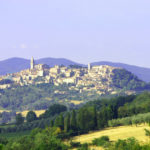Stained Glass Windows In Arezzo
I went recently to visit Arezzo, it’s churches and to admire it’s beautiful stained glass windows specially preserved in the cathedral of the city.

Arezzo is a beautiful city of the Italian region called Tuscany, it’s origins are pre-Etruscan it’s situated in a strategic area being a natural passage of the Tuscan Apennines, it was a thriving city in the Etruscan and Roman time, and that certainly has had its greatest importance in the Middle Ages.
The buildings of the old town center are in a medieval style with mullioned windows and Gothic shaped arches, some of them with leaded quarries and bull’s eye panels, but to admire the glass art work of the city you should certainly get into his cathedral.
The construction of Arezzo’s Cathedral began in 1277 still reveals a Romanesque basic footprint, the façade is made with sandstone, it has marble decorations mainly concentrated around the central entrance which is the most recent part, completed in 1914 to replace the original unfinished fifteenth century .
Apart from the stained glass windows that we’ll discuss, the Cathedral of Arezzo contains works of great importance such as the fresco of Mary Magdalene dating from about 1460 masterpiece of Piero della Francesca and the painting that adorns the baptistery dated 1548 by the hand of Giorgio Vasari.
But the Arezzo Cathedral is undoubtedly famous especially for its stained glass windows.
The mullioned windows of the naves are entirely made in the early sixteenth century by artist Guillaume de Marcillat (1470-1529), probably portrait in the window of the baptism of Christ, 1519.

Particularly important in my opinion is also the stained glass window depicting Saint Lucia at the bottom and top San Silvestro pope, completed in 1517, which preserves an original and stunning face of the saint that I managed to photograph it for you.

In the apse, we can admire the modern stained glass window made in 1952 by the Florentine artist Ascanio Pasquini depicting Christ who comes to crown Our Lady of Assumption by the angels in heaven.


For more informations
Ask a Question


